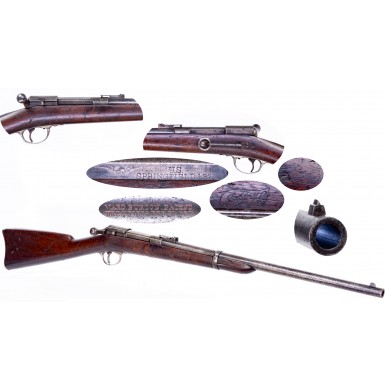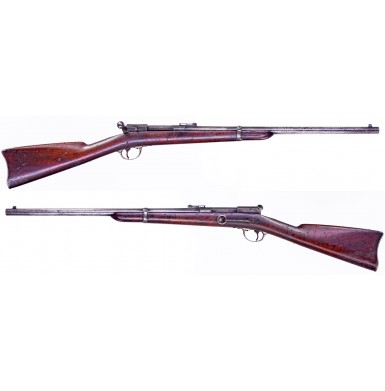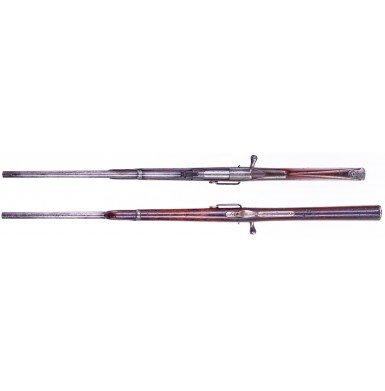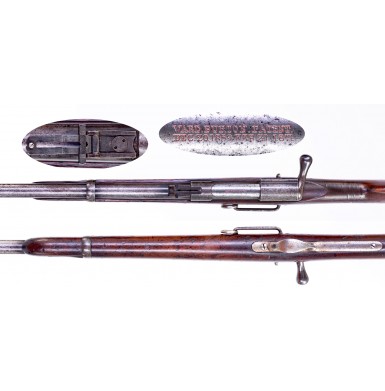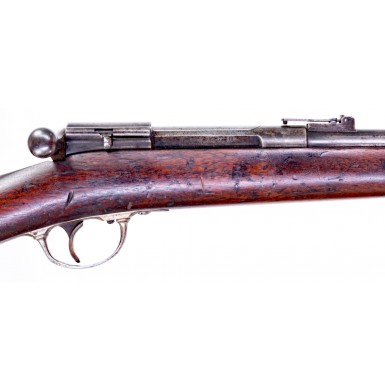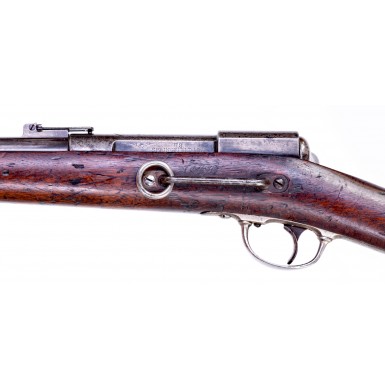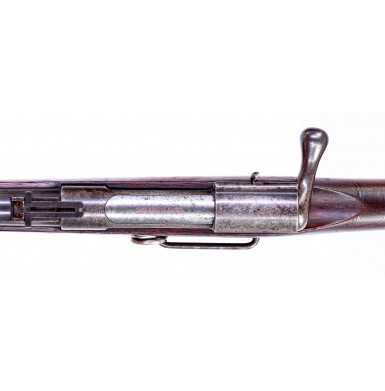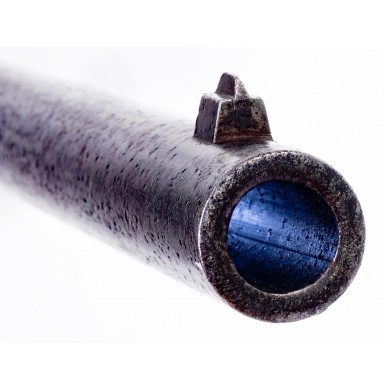Rare US Model 1871 Ward-Burton Trials Carbine
- Product Code: FLA-LG222
- Availability: Out Of Stock
-
$3,995.00
The end of the American Civil War made two things abundantly clear to the US Ordnance Department with regard to cavalry small arms. The first was that breechloading carbines had completed displaced muzzleloading carbines for mounted use. Secondly it was that the self-contained metallic cartridges had thoroughly displaced percussion ignition combustible cartridges for ammunition. However, in late 1865 and early 1866 the Ordnance Department found themselves with a dizzying array of patent breechloading carbine designs in service, in a variety of calibers. Many were .50 to .52 caliber single shot breechloading percussion ignition guns like the Maynard, Smith and Sharps. Others were single shot self-contained metallic cartridge guns like the 1864 Model Joslyn, the 2nd Model Gallager and the Ballard. Still others were repeating metallic cartridge designs like the Spencer and Henry Rifle. In an attempt to at least standardize the issue of metallic cartridge ammunition a decision had been taken in late 1864 to standardize chamberings to the new .50 rimfire Spencer cartridge used in the Model 1865 Spencer Carbine, which was known variously as the .56-50 Spencer and .50 Government Rimfire. This standardization had actually been applied to some of the new breechloading metallic cartridge carbines that were already contracted for production and changing the chamberings delayed the delivery of some new designs like the Palmer and Ball carbines until after the Civil War had concluded. A larger problem for the Ordnance Department was the fact that more than a million obsolete muzzleloading rifle muskets were in inventory for infantry use and these would need to be altered to breechloading cartridge guns to keep them viable until a new official breechloading long arm design was adopted.
The first attempt to solve the infantry rifle musket problem was addressed with the adoption of the US Model 1865 “1stAllin Conversion” Rifle. This alteration was developed by Springfield Arsenal Master Armorer Erskine S Allin and used a “trapdoor” system to alter existing stocks of muzzleloading rifle muskets to breechloading guns chambered for a new .58 rimfire cartridge. The following year a more robust, simpler and more efficient version was adopted as the US Model 1866 “2nd Allin Conversion” in the new .50-70 Government centerfire chambering. For the next few years, this would be the official US military long arm cartridge, until the venerable .45-70 Government was adopted in 1873. The infantry rifle would go through some modifications and improvements over the next few years, resulting in the Model 1868, Model 1869 and Model 1870 rifles. However, the cavalry carbine situation was still very much up in the air.
By 1870 the cavalry was largely armed with two different patterns of carbines, with two very different schools of thought behind them. Roughly half of the cavalry was armed with the Model 1865 Spencer Carbine which was a seven-round repeating long arm chambered for the .50RF cartridge. Most of the balance of the cavalry were armed with the Model 1868 Sharps Carbine, a .50-70 Government single shot alteration of earlier New Model 1859 and New Model 1863 percussion carbines. The Spencer had the advantage of being a repeating design but the .50RF cartridge did not offer the range or downrange stopping power of the .50-70 cartridge. The Sharps was a simple and robust design well suited to the hard life carbines were exposed to on in the American West and fired a more powerful cartridge but was a single shot design. To the more conservative officers in the Ordnance Department a single shot long arm was considered preferable as it reduced the potential for a solider to “waste” his ammunition. To that end, many Model 1865 Spencer Carbines were equipped with the Stabler cut-off device that allowed the guns to be used as single shot weapons in most situations but allowing them to be used as repeaters in an “emergency” situation. At least one anecdotal example of the effectiveness of the Spencer with the Stabler cut off was a skirmish at Blanco Canyon between elements of the 4th US Cavalry and Comanches. The troopers initially used their carbines in single shot mode until they needed a hail of covering fire to retreat to a safer position and the rapid-fire ability of the carbines was heralded as the savoir of the troopers.
At this point the two primary carbines in use with the cavalry were Civil War era designs, the Spencer and the altered Sharps carbines. The standard infantry arm was based upon an alteration of Civil War period muskets. In all cases it was not clear that these were the best designs to move forward with as “purpose built” breechloading cartridge long arms. Interestingly the British military was grappling with the same problem, as their Snider alteration of the Enfield Rifle Musket had been adopted as a stop gap system to alter existing muzzleloading arms, but it was not clear that this was the best system to utilize for purpose-built arms either. As a result, in August of 1870 the Ordnance Department authorized the manufacture of 1,000 breechloading infantry rifle muskets and 300 breechloading carbines at Springfield Arsenal based upon four different designs to issue for field trials. The designs were all single shot and were all to be chambered for the .50-70 Government cartridge, indicating the faction more concerned about cartridge power and wanting to avoid ammunition wastage won out. The designs to be tested were the Springfield “Trapdoor” system, the Remington “Rolling Block”, the Sharps system and finally the Ward-Burton system. The “Schofield Board” which had been established the preceding year to examine the best potential small arms designs for use in the service. Led by General Schofield, their June of 1870 report noted that only the .50-70 Springfield, Sharps and Remington designs were worthy of field testing. The board later amended their recommendations to include the Ward-Burton design as well. The Trapdoor system was already familiar to the troops in the field, as was the Sharps system. The Remington Rolling Block system was simple, strong and very easy to learn and operate. The Ward-Burton system, however, was a very advanced and potentially confusing design for troops who would have them issued to them in the field.
The Ward-Burton system was the first true bolt action breechloading long arm to be issued for US military use. While two other bolt action designs had been acquired by the US military in the past, neither was a true modern bolt action design. The Greene Bolt Action rifle as an underhammer capping breechloading design that used nitrated paper cartridge, so it was not a real bolt action firearm, despite using a rudimentary bolt to load the cartridge. The Palmer Carbine which had been ordered during the closing months of the Civil War but delivered too late to see service was a bolt action metallic cartridge breechloader that used interrupted threads as a locking mechanism for the bolt. However, the Palmer used an external hammer which had to be cocked to fire the gun. The Ward-Burton was a real bolt action system with a “cock on closing” bolt that required no additional cocking action to make it ready to fire.
The Ward-Burton was based upon two US patents held by the partners in design, Bethel Burton and William Ward. Burton was a firearms inventor who received six different patents regarding breechloading firearms and ammunition designs between 1859 and 1873. His design for a bolt action breechloading percussion ignition carbine actually landed Burton in jail in 1861. Since he could not interest the US Ordnance Department in his design he approached the State of Virginia, and by extension the Confederacy, with a proposal to help produce 50,000 of the guns based upon his 1859 Patent #24475. The end result was that the Lincoln administration jailed him for some six-months for the potentially treasonous activities. In 1868 Burton received US Patent #81059 which was the basis for the Ward-Burton design. That same year he met and entered a partnership with General William Greene Ward. Ward had served as the Colonel of the 12th New York Infantry during the Civil War and was on the New York State militia’s board of ordnance. Ward was also interested in breechloading firearms designs and received a total of five patents in that field between 1869 and 1871. In February of 1870 he received US Patent #99504 for improvements to the extractor and ejector system of Burton’s bolt action design covered by Patent #81059. This is the patent most often noted by writers when discussing the Ward-Burton design. However, the patent date on the gun is February 21, 1871, which references Ward’s US Patent #111994. This patent was also for improvements on Burton’s design, with the most important being the safety which would be incorporated into the guns. This would become what the world would know as the Ward-Burton rifle and carbine. It is interesting to note that the Ward-Burton design was added to the Schofield Board’s recommendations as almost an afterthought, likely due to Ward calling in some favors from his Civil War service days with various officers in the Ordnance Department. There is even some indication that Ward communicated directly with Springfield Master Armorer Erskine S Allin to help get his design into the field trials. As a result of the late addition to the 1870 Trials, the Ward-Burton would be officially designated as the US Model 1871 Ward-Burton Rifle or Carbine and would not reach troops in the field until some months after the other arms had already been in field testing for some time.
The Model 1871 Ward-Burton was a single shot, bolt action, cock on closing metallic cartridge firearm with a 22” barrel and a single barrel band in the carbine configuration and a 32 1/8” barrel and two barrel bands in the rifle configuration. The guns were finished National Armory Bright with case-colored receivers. The action had a safety lever on the right rear of the receiver. The rear sight was of the US 1868 pattern and the front sights were the traditional military musket style blades on rectangular bases with the base serving as a socket for an angular socket bayonet for the rifle. The rifle was equipped with two sling swivels while the carbine utilized a sling bar and ring suspension system. Production figures vary slightly based upon sources, with most reports noting that 313 of the carbines and 1,013 of the rifles were produced at Springfield circa 1870-71. From 1872 to 1872 Ward-Burton Rifles and Carbines were field tested by a number of infantry, artillery and cavalry regiments. At least 18 different infantry and artillery regiments were issued as few as 20 and as many as 96 of the rifles, with 8 different cavalry regiments being issued the carbines. The largest issuance of the carbines was to the 6th and 7th US Cavalry regiments in 1872, who received 54 and 56 carbines, respectively. The smallest number issued was to the 3rd Cavalry which received 14 in 1872 and only had 13 in 1873, suggesting one was lost, damaged or returned to the arsenal for repair. Other cavalry regiments to receive the Ward-Burton Carbine for testing were the 1st, 2nd, 4th, 5th and 9th. Only the 6th and 10th US Cavalry did not test the Ward-Burton design, in fact the 10th US Cavalry did not receive any of the 1870 trials carbines for testing. Based upon records researched by John D McAulay, 166 of the carbines were in service in June of 1872 and 199 were in service in June of 1873.
The Ward-Burton did not receive particularly favorable reports from the field from the officers supervising the men using them. Although initially some infantry officers were impressed with the design, and at least one officer felt the Ward-Burton was more accurate than the Springfield, and a cavalry officer in Company F of the 7th US Cavalry (Custer’s command) noted that “For rapidity of fire, there appears to be little choice between the Ward-Burton and the Springfield, both of which excel in that respect.” However, these positive opinions soon changed.
The biggest issue revolved around the gun’s bolt action system. The cock on closing action meant that as soon as the gun was loaded it was ready to fire and if the safety was not applied and good trigger discipline was not maintained, the guns could be fired unintentionally. The lack of a manual, intentional cocking system or a visible cocking indicator like the traditional musket hammer made the guns inherently dangerous to poorly trained troops. As a result, many of the men, and their officers were soon afraid of the guns. An officer in Company C of the 13th Infantry noted that: “I have the honor to add that in consequence of the number of accidents occurring in using the Ward-Burton arm, the men of my company are afraid to use them.” Reports also started to be received regarding bolt failures from poor heat treatment and of weak firing pin springs which would not reliably detonate cartridges. Another complaint was that the action was susceptible to being hard, or even impossible to operate, if the action became dirty. One extreme case of failure in combat took place during a skirmish with the Modoc Indians in the Lave Beds of California in April of 1873. During an armed reconnaissance against the Natives in the Lava Beds, elements of the Battery K 4th US Artillery and Company E of the 12th US Infantry were partially armed with Ward-Burton Rifles. The troops were ambushed and pinned down for a period of time, with many fighting for roughly two hours before the Native ambushers withdrew. After the action it was reported that all of the Ward-Burton Rifles in use with the artillery regiment became disabled during the combat, while the Model 1870 Trapdoor Rifles performed flawlessly. Cavalry officers had similar complaints about the guns being potentially dangerous because of the cock on closing bolt, no external cocking lever and no cocking indicator. Again, complaints about weak firing pins were received and at least one officer complained that the operation of the gun was simply too complicated for men on horseback. An officer in Company E of the 2ndUS Cavalry noted that the gun was: “Too complicated for cavalry service. The Ward-Burton fails often to explode the cartridge, which is caused by the firing-pin spring becoming weak. The extractor is good, but as the piece is always cocked and there are so many motions which consume time in working the gun, it is not, in my opinion, adapted for the cavalry service.”
Out of some 95 reports and recommendations from the field, none recommended the Ward-Burton for adoption. It is worth noting that the other competitors were not particularly well thought of either. The Sharps was noted to have fouling issues that made the breechblock difficult to operate and the Remington was noted to have extraction issues, particularly when the gun was hot or fouled. Only the Springfield Trapdoor design received somewhat universal praise. Due to the lack of positive feedback, by 1874 nearly all of the Ward-Burtons had been withdrawn from service. As the decision had been taken in 1873 to proceed with the universal adoption of the Springfield Model 1873 Trapdoor series of arms in .45-70, the Ward-Burton’s use as a military long arm came to an end rather quickly.
Offered here is a very rare US Model 1871 Ward-Burton Carbine. Depending on which references you rely on somewhere between 313 and 316 of the guns were produced at Springfield Arsenal during the latter part of 1871 and 1872 for use in field trials during 1872 and 1873. The gun remains in NEAR VERY GOOD condition and appears to be complete and correct in every way. Due to the harsh conditions in which the guns were used, most surviving examples are well worn and show heavy use. The gun is clearly marked in two lines on the top of the bolt:
WARD.BURTON.PATENT
DEC. 20. 1859 FEB.21 1871
The left side of the receiver is stamped with an American {Spread-Winged Eagle}, followed in two lines:
U.S.
SPRINGFIELD 1871
The reverse of the stock bears a pair of inspection cartouches. These include a script JWK in a ribbon over the sling bar and a script ESA in an oval to the rear of the sling bar. These are the marks of Springfield Armory sub-inspector John W Keene and Master Armorer Erskine S Allin, respectively. The tang of the buttplate is marked U.S. and the single barrel band is marked “U” for up on the right side. All of the markings remain clear and fully legible, even the cartouches in the stock. The carbine retains its original 1868 pattern ladder rear sight, the original base and blade front sight and the original sling bar and ring. The carbine remains mechanically functional operates as it should. The bolt disengages when the lever is rotated 90-degress upwards and can be drawn backwards to eject and then load a cartridge. The bolt cocks on closing as it should, and safety lever can be engaged and functions as it should as well. With the action cocked and the safety off, the firing pin releases as it should when the trigger is pulled. The bore of the carbine is in about GOOD+ condition. It is partially bright with moderate oxidation and discoloration and shows scattered pitting along its length, while retaining strong three-groove rifling.
As noted, the gun is in NEAR VERY GOOD condition. The receiver retains some traces of its original arsenal case colored finish in the protected areas with crisp markings. The arsenal bright barrel and furniture show moderate oxidation and have a heavily mottled and freckled “salt & pepper” patina with a dull gray base metal showing moderate amounts of scattered oxidation and discolored freckling. The metal shows moderate to heavy pinpricking combined with light pitting over nearly all of the exposed metal surfaces. The metal was probably cleaned long ago, leaving the dull gray color which is toning down and contrasts with the freckled oxidized discoloration. There are also some scattered patches of surface roughness on the metal here and there. As noted, these guns tended to see somewhat hard use in harsh environments, so surviving examples tend to be hard used. The stock shows moderate wear as well with numerous bumps, dings and mars from carry and use. The stock is full-length and free of any breaks or repairs but does show a lot of use and a small surface crack. This is located on the reverse of the stock at the rear of the receiver that angles around towards the wrist. It is tiny and tight and difficult to see, but it is mentioned for exactness. There are also a couple of small minor slivers of wood missing along the upper edge of the forend and around the barrel band, with the balance of the stock showing evenly distributed dings, scuffs, mars and scrapes. Despite the heavy wear to the wood, there is no indication of any sanding, refinishing or repairs and the cartouches remain in really nice shape, indicative of the honest use the gun saw during its service life.
Overall, this is a very solid, complete, correct and authentic example of a scarce US Model 1871 Ward-Burton Cavalry Carbine. The gun has an attractive “been there, done that look” and it would be wonderful if it could tell the story of its adventures during the field trials in 1872 and 1873. The gun could have seen service against the Modocs in California, the Apaches in the southwest, or in any number of locations across the Great Plains and American West. This gun was simply too advanced for its time and in an era of more modern weapons or a better trained military it would almost certainly have been adopted over the Trapdoor as the design was superior on many levels. This is one of those rare carbines from the decade of reorganization and rearming of the American military between the end of the American Civil War and the Battle of the Little Bighorn. Many experimental gun designs saw limited use and were then discarded to the trash heap of history, only to become a footnote in firearms development history. If you collect American military carbines this is one you probably don’t have in your collection, and in particular if your interest is in the Indian Wars period and post-Civil War military arms development, this is a gun you really need to have. I am certain that you will be pleased to add this rare carbine to your collection and despite its well-worn appearance, it still presents very well and displays quite nicely.
ON HOLD

